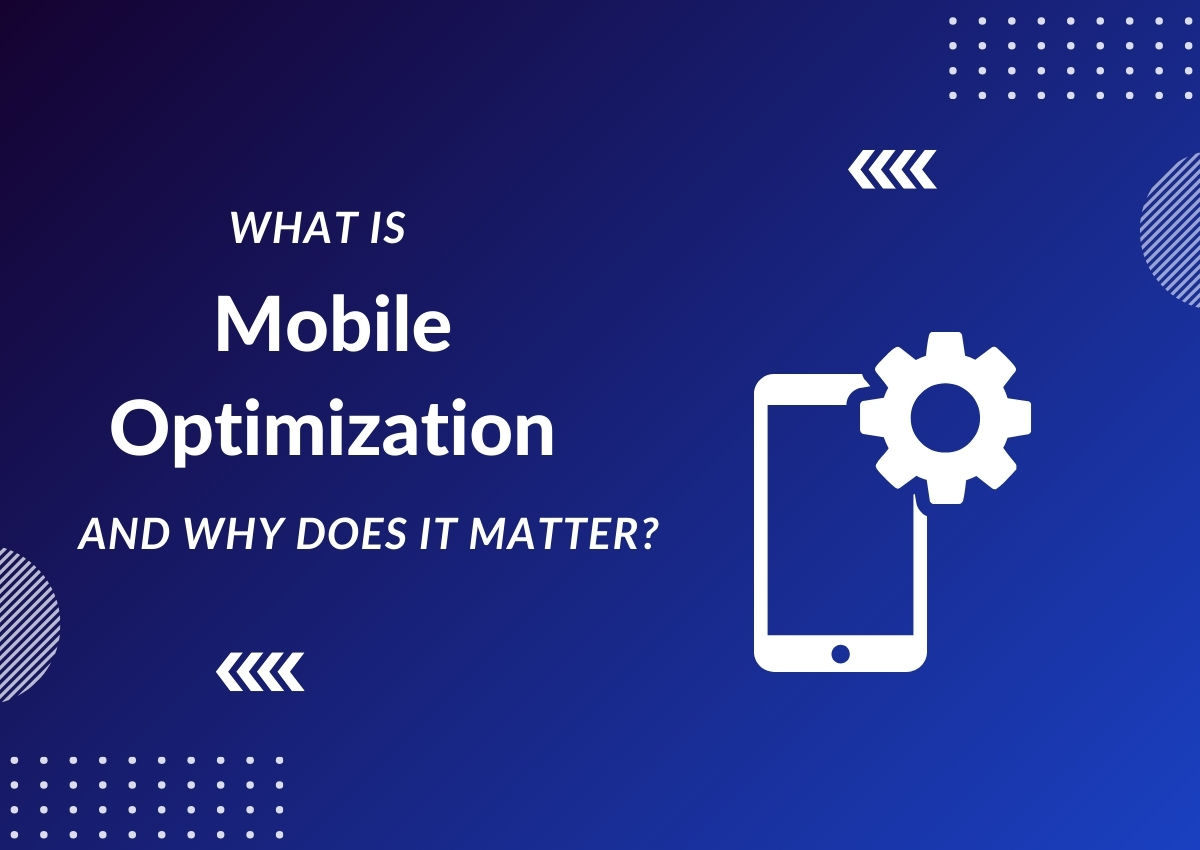What is Mobile Optimization, and Why Does It Matter?

Mobile devices have become an integral part of our daily lives, and the number of people using them to access the internet is increasing rapidly.
About 92.3% of internet users access the internet through their mobile devices, making it crucial for businesses to optimize their websites for mobile viewing.
But what exactly is mobile optimization, and why does it matter?
In this guide, I will break down the basics of mobile optimization and explain why it is essential for any business or individual with an online presence.
I will also give some key insights to help you optimize your website for mobile devices, so let’s get started!
What is Mobile Optimization?
Mobile optimization is about making sure that your website or app is accessible and user-friendly on mobile devices.
This means designing your site or app in a way that makes it easy to navigate, read, and interact flawlessly on smaller screens.
For example, when you visit sites like Amazon or Walmart on your phone, you’ll notice that the design and layout differ from their desktop versions.
This is because they have optimized their sites for mobile users, taking into consideration the smaller screen size and touch-based interaction.
Why is Mobile Optimization Important?
With more and more people using smartphones as their primary device to access the internet, it’s crucial that websites and apps are optimized for mobile usage.
In fact, a study by GSMA showed that in 2023, 57% of worldwide internet traffic came from mobile devices. That is up from 50.3% in 2017 and 43.6% in 2016.
This number is only expected to increase in the coming years.
If your site is not optimized for mobile, you risk losing potential customers who are frustrated with a difficult-to-navigate or poor user experience.
Additionally, search engines like Google also prioritize mobile-friendly sites in their search results, so optimizing your site can also improve its visibility and ranking.
So, mobile optimization is crucial for your digital presence if you want to reach a larger audience and stay ahead of the competition.
Benefits of Mobile Optimization
Improved User Experience:
By optimizing your site for mobile, you make it easier for users to access and navigate, resulting in a better overall experience.
Optimizing websites for mobile usage requires faster page load time, easier navigation, and simplified content layout or structure.
All these factors contribute to a smoother and more enjoyable experience for your website users.
Higher Conversion Rates, Traffic & Engagement:
Sites that are optimized for mobile can also lead to higher conversion rates.
According to Google,
If a user lands on your mobile website and is frustrated or doesn’t see what they are looking for, there’s a 61% chance they will leave immediately and go to another website.
On the other hand, a good mobile experience results in users spending more time on your site, engaging with your content, and potentially leading to conversions.
Additionally, more people using their phones to access websites prefer mobile-friendly sites for purchases or buying services. This results in more traffic and, ultimately, higher engagement for your site.
Improved SEO:
As mentioned earlier, search engines like Google prioritize mobile-friendly sites in their search results. Google gives a boost to the ranking of sites that are optimized for mobile.
This means that, by optimizing your site for mobile, you improve its chances of ranking higher in search engine results pages (SERPs), leading to increased visibility and potential traffic for your website.
Competitive Advantages:
Responsive websites with better layouts, content structure, and easier navigation are more likely to attract users browsing on their mobile devices. This gives you a competitive edge over websites that have not yet optimized for mobile.
As humans are creatures of habit, they often stick around with anything that repeatedly gives them a good outcome.
Therefore, providing a good user experience through mobile optimization can result in loyal customers who keep coming back to your site.
Now that you know the benefits and importance of mobile optimization, let’s take a look at some key insights on how to do it effectively!
Key Elements for Successful Mobile Optimization
Prioritize Responsive Design:
A responsive design is essential for mobile optimization, allowing your site to adapt to different screen sizes without losing functionality or aesthetic appeal.
This means that whether a user accesses your site on a desktop, tablet, or smartphone, the layout and content adjust accordingly for optimal viewing.
The most common responsive design tactics are:
- Identifying and displaying the most important content first
- Using a grid layout that adjusts to different screen sizes
- Eliminating pop-ups
- Implementing intuitive navigation options (such as a sticky menu or hamburger menu)
- Optimizing images and media for different screen resolutions.
By implementing a responsive design, you ensure your site looks and functions well on all devices, providing a positive user experience regardless of the device used.
Optimize Page Speed Load Time:
Mobile users expect fast page load times, and any delays can result in frustration and a higher likelihood of leaving your site.
To optimize for speed, you can:
- Minimize HTTP requests
- Compress images and media files
- Minifying code
- Utilizing browser caching
- Using a content delivery network (CDN).
Simplify Site Structure & Navigation:
Mobile screens are smaller, so it’s essential to simplify your site’s layout and content for optimal viewing. This means using fewer images, shorter paragraphs, and simpler navigation options.
Keep in mind that users are often using one hand to navigate on their phone, so it’s essential to make it easy for them to find what they’re looking for without too much effort.
Streamline Content:
On a smaller screen, it’s essential to be concise and direct with your content.
Avoid lengthy paragraphs or excessive scrolling by breaking up text into smaller chunks and utilizing bullet points or numbered lists to make information more digestible.
Don’t overwhelm your mobile users with too much information; instead, focus on highlighting the most important points for a user-friendly experience.
This can also improve page load time and keep users engaged with your content.
Utilize Mobile-Friendly Features:
Take advantage of features that enhance the mobile browsing experience, such as click-to-call buttons or one-click purchasing options.
Try to limit the number of steps it takes for a user to complete an action on your site.
These mobile-friendly features make it easier for your user to take action quickly and efficiently, increasing the chances of conversion.
Test and Measure:
Before implementing mobile optimization, it’s essential to test and measure your site’s performance on different devices.
This allows you to identify any issues or areas for improvement and ensure that your site is functioning properly on all devices.
You can use tools such as Lighthouse or other Chrome dev tools to assess your site’s mobile-friendliness and track any changes in performance after optimization.
Continuously testing and measuring can also help you identify any ongoing issues that may arise.
Common Mistakes to Avoid in Mobile Optimization
Optimizing a website for mobile can be challenging, and there are some common mistakes that many people make.
Here are some of the most common mistakes to watch out for:
- Not considering different devices: Remember to optimize for both smartphones and tablets, as screen sizes differ between the two. A non-responsive website that doesn’t adapt to different screen sizes can lead to a poor user experience.
- Neglecting slow load time: Slow load times can result in frustrated users and a higher bounce rate. So, ensuring your site is optimized for speed is very important.
- Cluttered design: A cluttered design can make it difficult for users to navigate and find what they want on a smaller screen. Keep things simple and structured for the best user experience.
- Neglecting mobile-specific features: Mobile devices have some unique features like touchscreens, voice search, and click-to-call. Utilizing these features can enhance the user experience and improve conversion rates.
- Not testing properly: Skipping proper testing before launching your mobile site can result in issues that could have been easily avoided. Make sure to thoroughly test on various devices and browsers to measure performance before making your site live.
Wrapping Up
With the increasing usage of smartphones for internet access, mobile optimization is a must in today’s digital landscape.
Businesses that prioritize mobile optimization are likely to get more advantages than those that don’t.
By following these key elements and avoiding common mistakes, your website will be well on its way to providing an exceptional mobile experience for your users.
So, Start implementing these tactics today and see the positive impact on your site’s performance.
And If you need any help from me, don’t hesitate to reach out. I’d be happy to assist you on your journey towards successful mobile optimization!
Thanks for reading!
